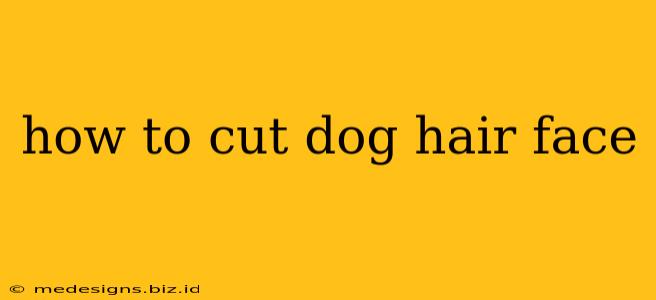Trimming your dog's face hair might seem daunting, but with the right tools and techniques, it's a manageable task that can enhance your dog's appearance and comfort. This guide provides a comprehensive, step-by-step approach to safely and effectively cut your dog's face hair at home. Remember, if you're uncomfortable or unsure at any point, it's always best to consult a professional groomer.
Preparing for the Cut: Essential Tools and Techniques
Before you even think about picking up the clippers, preparation is key. This minimizes stress for both you and your furry friend.
Gather Your Supplies:
- Sharp, high-quality dog grooming scissors: These are crucial for precise cuts and to avoid pulling or snagging your dog's hair. Look for rounded-tip scissors to prevent accidental injury.
- Dog grooming clippers (optional): Clippers are useful for longer hair, but scissors offer more control for delicate areas like the face.
- A comfortable, well-lit workspace: Choose a quiet area where your dog feels safe and you have good visibility.
- Treats and toys: Positive reinforcement is essential to keep your dog calm and cooperative.
- Soft towel or brush: This helps remove loose hair and keeps your dog clean.
- Stop-bleed powder (optional): While accidents are rare, this is a good precaution to have on hand.
Acclimating Your Dog:
- Introduce the tools gradually: Let your dog sniff and investigate the clippers and scissors before you even turn them on. Reward them with treats for calm behavior.
- Practice sessions: Start by simply touching your dog's face and rewarding them. Gradually work towards gently holding their face for short periods.
- Positive reinforcement: Keep the experience positive and rewarding. Never force your dog into anything they are uncomfortable with.
Step-by-Step Guide to Trimming Your Dog's Face Hair
Remember to always work slowly and methodically. If your dog shows signs of stress or discomfort, take a break and try again later.
1. Cleaning the Face:
Start by gently wiping your dog's face with a damp cloth to remove any dirt or debris. This ensures a clean cut and makes it easier to see what you're doing.
2. Assessing the Hair:
Carefully examine your dog's face hair. Identify areas that need trimming – this may vary depending on your dog's breed and hair type. Avoid cutting too close to the skin.
3. Trimming the Hair:
- Around the Eyes: Use sharp scissors to carefully trim any hair that obstructs your dog's vision. Work slowly and gently, holding the skin taut to avoid accidentally cutting your dog.
- Around the Mouth: Carefully trim away any long hairs around the mouth that may interfere with eating or drinking.
- Between the Pads: Use scissors to trim excess hair between your dog’s paw pads, improving traction.
- Muzzle: If your dog has hair around the muzzle that is getting in the way, carefully trim it to a manageable length.
4. Finishing Touches and Cleanup:
Once you've trimmed the necessary areas, use a soft brush or cloth to remove any loose hair. Reward your dog with plenty of treats and praise.
Important Considerations:
- Breed-Specific Considerations: Certain breeds have specific grooming needs. Research your dog's breed to understand its unique requirements.
- Sensitive Skin: Some dogs have sensitive skin. Use blunt-tipped scissors and be extra gentle to avoid irritation.
- Professional Help: If you are uncomfortable or your dog is particularly anxious, seek professional help from a qualified groomer.
Following these steps and prioritizing your dog's comfort will ensure a successful and stress-free grooming experience. Remember to always maintain patience and positivity!
